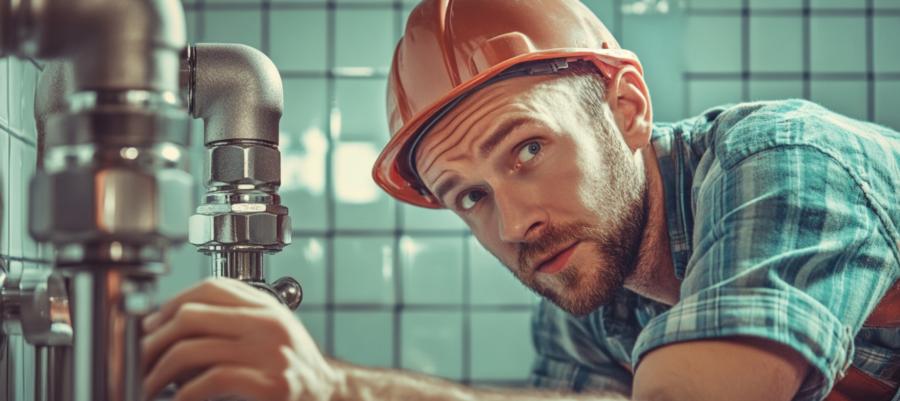Overtightening Fittings: More is Not Always Better
Imagine this: you’re installing a new faucet, and you think, “I’ll just tighten it a bit more to make sure there’s no leak.” Fast forward a few minutes, and you’ve cracked a fitting or stripped a thread. Overtightening is one of the most common mistakes homeowners make when attempting DIY plumbing. Metal fittings are particularly unforgiving. What feels like a snug fit to you might actually be the start of a catastrophic flood waiting to happen.A seasoned plumber knows the difference between tight and too tight. They’ve developed a finely tuned sense of how much pressure is required, saving you the heartbreak of watching your brand-new fixture fail right in front of your eyes.
Forgetting to Turn Off the Water Supply: A Rookie Error
It’s astonishing how often people forget this fundamental step: turn off the water before you begin! One minute, you’re unscrewing a pipe, feeling like you’re nailing it, and the next minute, water is gushing out, soaking your floor, and drowning your confidence. Turning off the water isn’t just a step—it’s the step.An experienced plumber, by contrast, doesn’t skip this. Ever. They know where the shutoff valves are, how to isolate specific lines, and avoid unnecessary water park-like chaos. They come prepared, not only with the right tools but with the right mindset—one that doesn’t forget the basics.
Using the Wrong Tools: Not All Wrenches Are Created Equal
Let’s face it, not all of us own a professional-grade set of plumbing tools. In fact, many DIYers reach for whatever wrench they can find, assuming it’ll do the trick. Sadly, this can lead to using inappropriate tools, which often damages delicate plumbing parts or just makes the job way harder than it needs to be.Using a pipe wrench to fix a faucet or a crescent wrench to handle delicate compression fittings is a recipe for disaster. Plumbers, however, bring the right tool for every task. With a toolbelt filled with specialized equipment, they avoid the tool-induced damage that too often follows DIY attempts. Think of it this way: you wouldn’t use a butter knife to tighten a bolt—so why use the wrong tool on your plumbing?
Mismatched Pipes: A Recipe for Future Leaks
Mixing different types of pipes—like copper and galvanized steel—might seem harmless at first. After all, they’re both pipes, right? But here’s where chemistry crashes your DIY dreams: these metals don’t play nicely together. When combined, they can cause corrosion, leading to leaks, burst pipes, or worse.An experienced plumber knows how to choose compatible materials, using dielectric unions to connect different types of metal pipes safely. Their knowledge of building codes and materials science ensures that your home’s plumbing system remains durable and functional long after the repair is done.
Ignoring Slope in Drain Pipes: The Gravity of the Situation
Here’s a plumbing detail that doesn’t get much attention in DIY circles: drain pipes need the proper slope to function. Too much slope and the water outruns the waste; too little and the waste just sits there, which is as gross as it sounds. Without the right angle, you could end up with clogs and backups that will make you question every decision that led to this point.A professional plumber knows the exact slope required for drain pipes. By following precise measurements and local plumbing codes, they ensure that your waste and water flow in harmony. No one wants to experience what happens when they don’t.
Misunderstanding Sealants: Tape Isn’t Always the Answer
One of the classic mistakes in DIY plumbing is the overuse (or misuse) of plumber’s tape or sealant. Many a homeowner has wrapped half a roll of tape around a thread, thinking it will magically stop all leaks. In reality, this often leads to ineffective seals, and sometimes makes things worse. Plumber’s tape has its place, but it’s not a one-size-fits-all solution.A professional plumber knows when to use tape, when to use a different kind of sealant, and when you shouldn’t use any at all. By properly applying the right sealing materials, they ensure a watertight connection without the risk of leaks down the line.
Plumbing Your Own Depths
At the end of the day, DIY plumbing might save you a few pounds in the short term, but it often leads to more headaches (and repairs) in the long term. An experienced plumber not only saves you from the obvious disasters but also from the hidden problems that DIYers tend to overlook. They bring knowledge, expertise, and a toolbox full of solutions—so your pipes flow smoothly, and your home stays dry.Article kindly provided by wetherbyplumbing.co.uk


